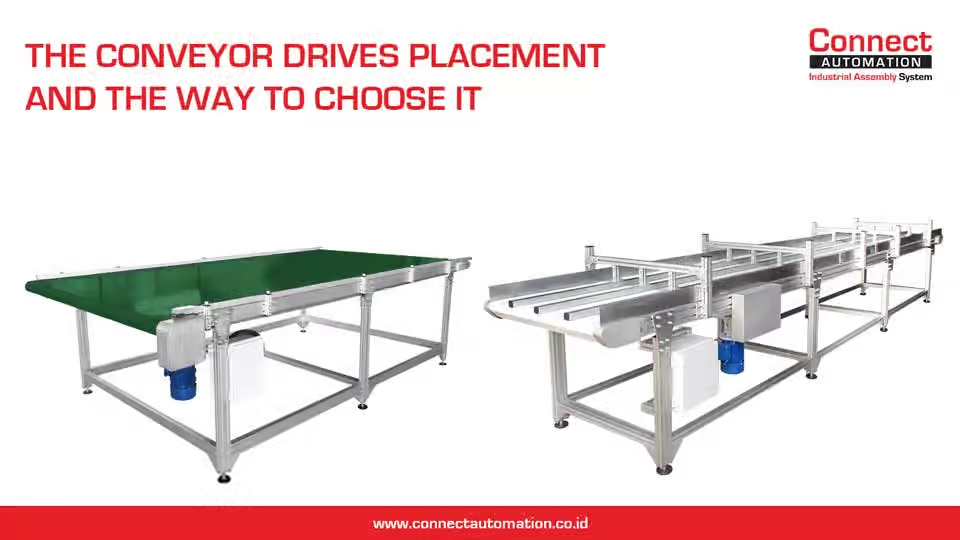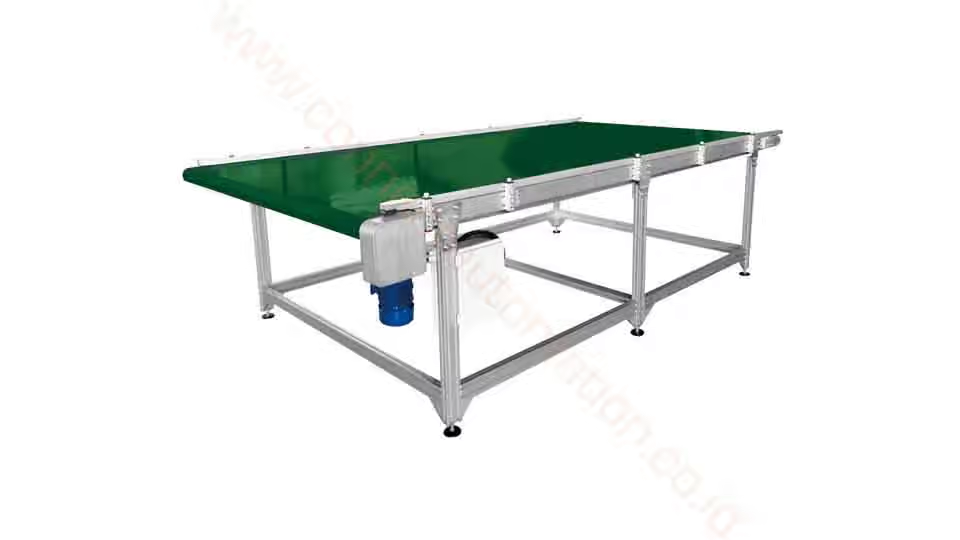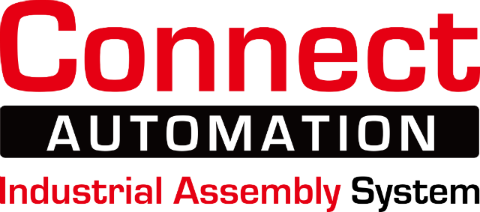REQUEST A FREE ESTIMATE!
Conveyor Drive Placement | Connect Automation

As we all know, a motor is one type of drive on a conveyor. A motor can directly move conveyor belt or indirectly by moving assembled parts connected to the motor.
-
There are 3 positioning of a conveyor motor, they are:
- End drive
- Center drive
- Internal drive
There is no such thing as the best place for motor placement for all situation. Motor drive is placed wherever it fits based on need and available physical room. When do you need to choose one of which? Read about it below!
Conveyor End Drive

As the name sounds, an end drive assembly is placed on one of the conveyor ends which usualy ends up in the end point of the conveyor. That being said, there are requirements for an end drive on the start point of a conveyor.
For the record, motor work far easier to pull products from an end point compared to when placed in start point. If you placed it in the start point, the motor have to push products along conveyor. Not really a big deal, but you still have to adjust it to what you need in your production lines. The best roller drive placement or the one we recommend is at the output point of a conveyor so it would pull and not push products.
End drive can be applied within a process without activities such as checking, sorting or labeling in the end of the conveyor. In other words, you need to take into account what activities will happen in this production line to apply an end drive conveyor. If it's still unlikely to use an end drive, you can still use a center drive conveyor.
Center Drive Conveyors
As cued in its name, center drive is palced on the middle of conveyor. You not only can put it on the dead center of the conveyor, but also anywhere along the conveyor frame.

Center drive or middle drive is usualy composed of 1 roller drive and 2 return rollers. The roller drive is palced between those return rollers / roller idlers. The roller drive itself usualy comes with a larger diameter than the other rollers on that same conveyor.
The placement of this drive is a tad bit more expensive compared to end drive conveyors. This is because you will need 2 roller idlers and a more complex design. Take those into account and make sure whether you really need center drive or if it would suffice using end drive conveyor.
Center drive on a conveyor is used when field environment disables the use of end drive conveyor. For example, the start and end point is going into a closed machine and therefore making it impossible to put a motor in any end of the conveyors
Internal Drive Conveyors
Both drive explained above is assembled on the exterior of the frame. This drive however, which commonly called power moller, places the motor inside the rollers.
This drive placement is a last resort when you can't put a motor on the conveyor frame. Unsupportive production line activities and position is one factor to use internal drive.
Internal drive itself haven't been used as a common practices in Indonesia, where most internal drives are imported or pre-ordered, causing a greater lead time. While its price which is certainly way above external drives (end and center drives), its size is far smaller because it is placed inside a roller.
How to Select a Drive
Just like what this article already stated earlier, that there are no such thing as the best roller placement for all condition and therefore there are multiple factors that affect drive placement on a conveyor.
There are 2 things to take into accounts when selecting a drive type and they are the activities which occur on the conveyor and the distance or placement between conveyors. First one is to consider what routine happens on the conveyor. For example if there are activities happening on both end of the conveyor, then you should better off with a center drive. This applies otherwise.
Second one is the distance and positioning between conveyors. For example if you can't put the drive on the end point then put it on the start point instead.
Consult Your Conveyor Needs with Connect Automation
Connect Automation have awesome and professional Sales Engineer teams that can give you the best solutions and recommendations for what you need. Learn more about our products:
Connect Automation specializes in providing automation solutions, including conveyor systems, to improve efficiency across various industries. The company delivers cutting-edge technology to help organizations automate tasks and optimize workflows. Connect Automation helps businesses reduce manual efforts, boost productivity, and achieve better outcomes. With a customer-focused approach, the company designs tailored solutions to ensure smooth and effective automation transitions for long-term success.
Kawasan Industri Jababeka Tahap 1, Jl. Jababeka II D Blok C14L Cikarang, Indonesia (17530)
(021) 893 5060 Google Maps
Rungkut Industri III, No. 37, Rungkut Menanggal, Kec. Gn. Anyar Surabaya, Indonesia (60293)
(031) 9985 8624 Google Maps
